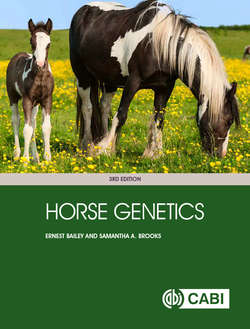Читать книгу Horse Genetics - Ernest Bailey - Страница 27
На сайте Литреса книга снята с продажи.
Оглавление3 Equus
The horse belongs to the family Equidae in the order of perissodactyl. The evolutionary history of perissodactyls is shown in Fig. 3.1 (Steiner and Ryder, 2012). The perissodactyls are herbivorous, hoofed mammals with an odd number of toes. The other extant perissodactyls include four species of Rhinocerotidae (Fig. 3.2) and four species of Tapiridae (Fig. 3.3).
Fig. 3.1. Phylogenetic tree for the perissodactyl family based on combined molecular genetic data. Dog (Canis) and cattle (Bos) serve as outgroups; data was collected from four species of Rhinocerotidae, four species of Tapiridae and nine species of Equidae (figure reprinted with permission from the Zoological Journal of the Linnean Society).
Fig. 3.2. Indian rhinoceros.
Fig. 3.3. Central American tapir.
The common ancestor of extant perissodactyls existed approximately 54 million years ago (MYA). Divergence of the three families occurred shortly after that (51 MYA) with the emergence of the Equidae family occurring only about 4–4.5 MYA.
The only extant members of the Equidae family are members of the genus Equus. The Equidae are generally regarded as belonging to four major groups: the horses (E. caballus and przewalskii), the donkeys (E. asinus), the Asiatic wild asses (E. kiang, kulan and onager), and the zebras (E. quagga, E. zebra, E. grevyi) (Table 3.1). Each species has the same general morphology and size as the domestic horse, but only the horse and donkey were amenable to domestication. Each species evolved adaptations to the environment in their region of the world. Consequently, they exhibit unique behaviors, unique physical characteristics, and unique genetic attributes.
Table 3.1. Extant species belonging to the genus Equus.
